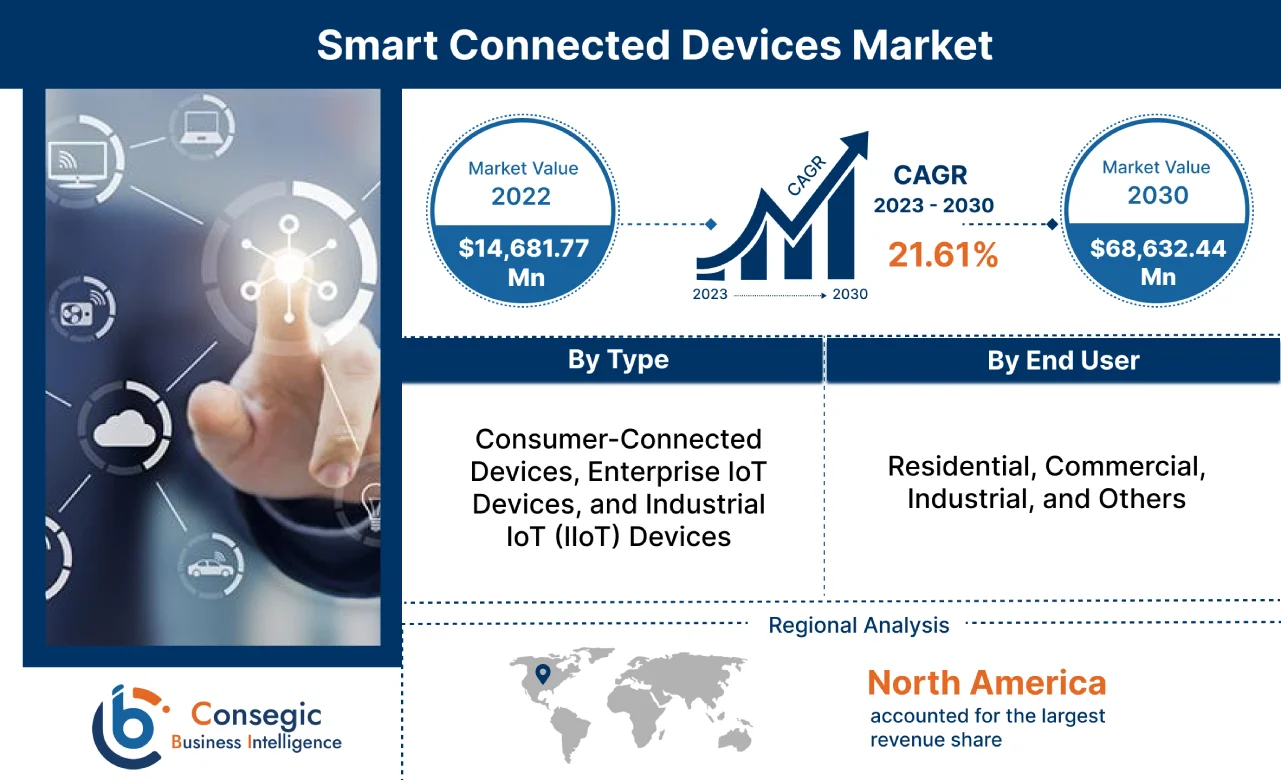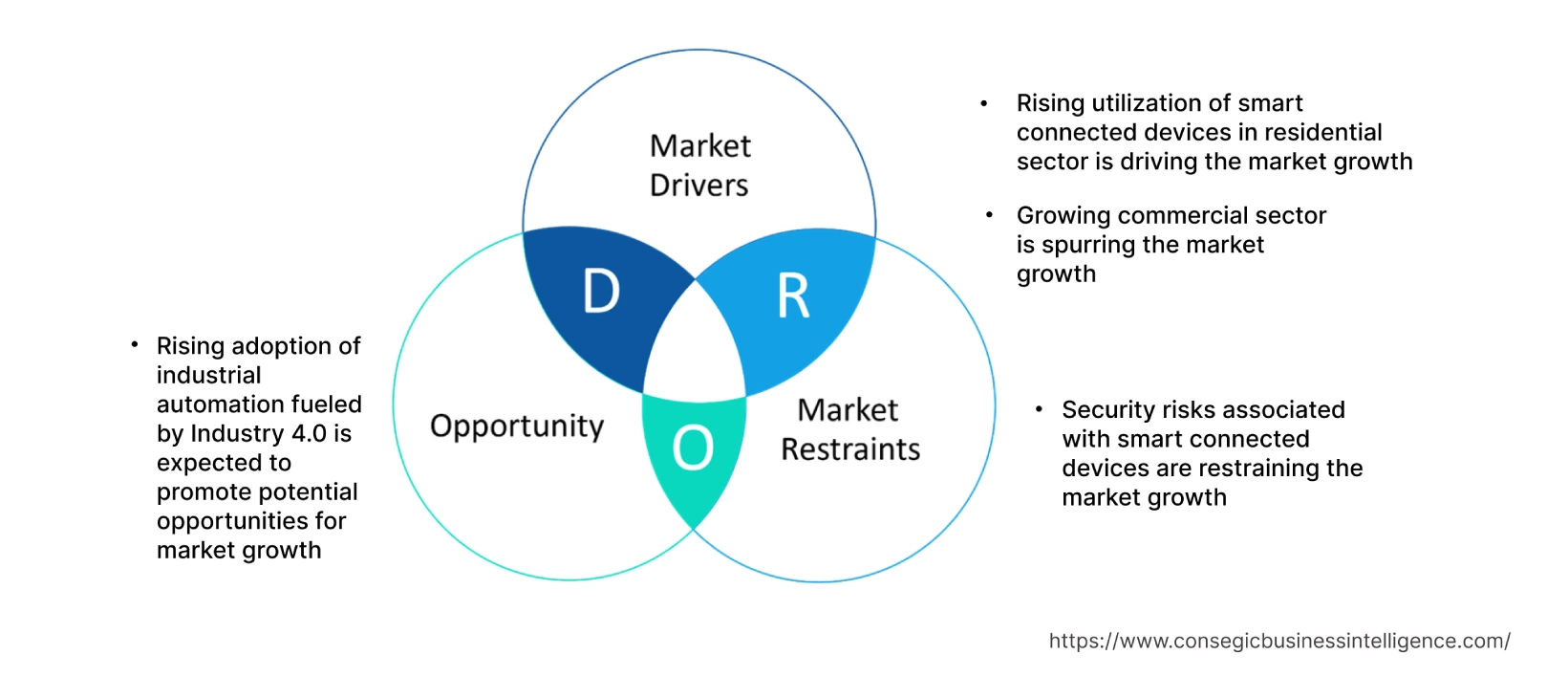- Summary
- Table Of Content
- Methodology
Smart Connected Devices Market Size :
Smart Connected Devices Market is estimated to reach over USD 68,632.44 Million by 2030 from a value of USD 14,681.77 Million in 2022, growing at a CAGR of 21.61% from 2023 to 2030.
Smart Connected Devices Market Scope & Overview:
Smart connected devices refer to electronic devices that are often connected to other devices or networks through various wireless protocols and are capable of operating interactively and autonomously. Smart connected devices offer a range of benefits including improved efficiency, increased convenience, enhanced safety and security, ease of personalization, higher flexibility, and accessibility among others. The aforementioned benefits of smart connected devices are key determinants for increasing its deployment in residential, commercial, and industrial sectors among others.
Smart Connected Devices Market Insights :
Key Drivers :
Rising utilization of smart connected devices in residential sector is driving the market growth
Smart connected devices including smart TVs, smart appliances, smart speakers such as Google Home, and others are primarily integrated in residential buildings. The benefits of smart connected devices including high reliability, ease of optimization, enhanced sustainability, improved energy efficiency, and autonomous operations are key determinants for driving its utilization in residential buildings.
Factors including the rising disposable income, growing investments and government policies including subsidies, rebates, and tax incentives for residential construction are among the major prospects driving the growth of the residential sector.
For instance, in 2022, the Government of the United Kingdom introduced a home-building fund to support new residential development in the country. The UK Government provides direct investments ranging from USD 2.5 million to USD 6.2 million to residential builders in the country.
Additionally, according to the State of Nevada of the United States, the new residential building permits reached 23,406 units in Nevada in 2021, depicting an increase of approximately 19% as compared to 19,716 units in 2020. Hence, the rise in residential construction is further driving the adoption of smart connected devices for installation in modern residential buildings for enhanced operations and improved energy efficiency, in turn proliferating the growth of the market.
Growing commercial sector is spurring the market growth
Smart connected devices including smart locks, smart lighting, smart thermostats, smart security systems, and others are installed in commercial buildings such as offices, educational institutions, retail outlets, and related applications. The deployment of smart connected devices in commercial buildings plays a crucial role in improving the building's operational efficiency.
Factors including rising pace of urbanization, increasing commercial construction, and expansion of business enterprises are among the key prospects driving the growth of the commercial sector.
According to CoreLogic Inc., the overall sales of commercial property in the United States witnessed significant growth in 2021. The total sales of commercial properties including offices, retail, hotel, and others inclined by 16% during the second quarter of 2021 in comparison to 2019.
Additionally, according to the Organization for Economic Co-operation and Development (OECD), China registered around 2.52 million new corporate companies in 2020. Hence, the growing commercial sector is increasing the adoption of smart connected devices including smart locks, smart lighting, smart thermostats, and smart security systems, thereby, driving the market growth.
Key Restraints :
Security risks associated with smart connected devices are restraining the market growth
Smart connected devices are integrated with several technologies including Bluetooth, Wi-Fi, IoT (Internet of Things), and others. However, the deployment of smart connected devices is often associated with certain security risks, which is a key factor constraining the market growth.
For instance, smart connected devices are prone to security risks including increased attack surfaces, unsecured hardware, unencrypted data transmissions, and domain name system (DNS) threats among others.
Additionally, smart connected devices are also vulnerable to IoT ransomware attacks, firmware exploitation, and malicious node injections. Hence, the aforementioned security risks associated with the implementation of smart connected devices are restraining the growth of the market.
Future Opportunities :
Rising adoption of industrial automation fueled by Industry 4.0 is expected to promote potential opportunities for market growth
The rising adoption of industrial automation is expected to present potential opportunities for the growth of the smart connected devices market. Industry 4.0 enabled manufacturing depicts extreme flexibility, automation readiness, minimal human intervention, and highest productivity. In addition, smart connected devices such as smart sensors, smart radiators, and others are used in smart factories, which are often enabled by the industrial Internet of Things (IIoT). The deployment of smart connected devices in industrial sector improves energy efficiency, sustainability, and enhances operational efficiency while facilitating automation in industrial processes.
Factors including the rising pace of industrialization, increasing investments in expansion of industrial manufacturing facilities, and rising trend of industrial automation fueled by Industry 4.0 are expected to promote lucrative growth aspects for the market.
For instance, the government of Germany launched the "Industry 4.0" initiative with the aim of promoting the development of digital technologies in manufacturing. The initiative also aims at supporting automation in manufacturing along with enhancing Germany's competitiveness in the manufacturing industry. Therefore, the rising government initiatives towards industrial automation is anticipated to increase the application of smart connected devices to enhance operational efficiency, in turn promoting opportunities for market growth during the forecast period.
Smart Connected Devices Market Report Insights :
| Report Attributes | Report Details |
| Study Timeline | 2017-2030 |
| Market Size in 2030 | USD 68,632.44 Million |
| CAGR (2023-2030) | 21.61% |
| By Type | Consumer-Connected Devices, Enterprise IoT Devices, and Industrial IoT (IIoT) Devices |
| By End-User | Residential, Commercial, Industrial, and Others |
| By Region | North America, Europe, Asia-Pacific, Latin America, and Middle East & Africa |
| Key Players | Rockwell Automation, Sony Electronics Inc., LG Electronics, NXP Semiconductor, Broadcom, PTC, SAMSUNG, HTC Corporation, Apple Inc., Lenovo |
Smart Connected Devices Market Segmental Analysis :
By Type :
Based on the type, the market is bifurcated into consumer-connected devices, enterprise IoT devices, and industrial IoT (IIoT) devices. The enterprise IoT devices segment accounted for the largest revenue share of 41.50% in the year 2022. Enterprise IoT devices include smart locks, smart thermostats, smart lighting, smart security systems, and others that are installed in commercial buildings such as offices, educational institutions, retail outlets, and others. Enterprise IoT devices vary in capabilities and play a significant role in maintaining a commercial facility or improving the building's operational efficiency.
In March 2022, Qualcomm Technologies Inc. launched its new smart connected camera solutions that are designed for securing and safeguarding enterprise environments and to enhance enterprise security and public safety. Thus, the rising innovations associated with enterprise smart connected devices are among the key factors driving the growth of the market.
The consumer-connected devices segment is anticipated to register fastest CAGR growth during the forecast period. Consumer-connected devices include smart TVs, smart appliances, smart speakers such as Alexa, Google Home, and others that are primarily designed for installation in residential buildings. Moreover, consumer-connected devices offer various benefits including higher convenience, improved energy efficiency, enhanced sustainability, autonomous operations, and others. The above benefits of consumer-connected devices make it ideal for utilization in residential and other sectors.
For instance, in October 2022, Apple Inc. launched its next-generation smart Apple TV integrated with 4K resolution. The Apple TV offers seamless integration with other Apple devices while adding convenience as a smart home hub. Therefore, the increasing advancements related to consumer-connected devices such as smart TVs, smart appliances, and others are anticipated to drive the market growth during the forecast period.
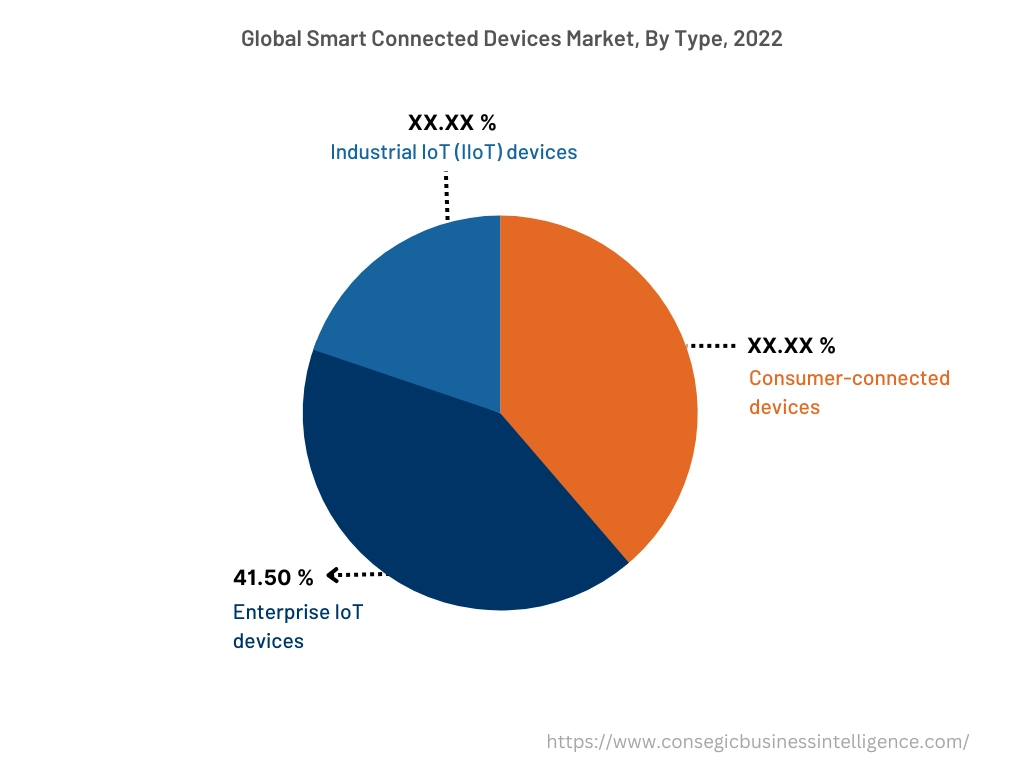
By End-User :
Based on the end-user, the market is segregated into residential, commercial, industrial, and others. The commercial segment accounted for the largest revenue share in the year 2022. Factors including rising pace of urbanization, increasing commercial construction, and expansion of business enterprises are driving the growth of the commercial segment.
For instance, according to the UK Office for National Statistics, the new private commercial construction orders in the United Kingdom were valued at USD 4,295.1 million during the fourth quarter of 2022, witnessing an increase of 5.5% in comparison to the fourth quarter of 2019. Therefore, the rise in commercial construction is driving the adoption of smart connected devices including smart locks, smart lighting, smart thermostats, and smart security systems in commercial buildings, in turn driving the growth of the market.
Residential segment is expected to witness fastest CAGR growth during the forecast period. The growth of residential segment is attributed to several factors including increasing disposable income, rising residential construction, and the increasing deployment of smart home devices for improved energy efficiency among others.
For instance, according to CoreLogic Inc., the sales of multi-family residential property in the United States witnessed significant growth of 26% during the second quarter of 2021 as compared to 2019. Therefore, the growth of residential sector is projected to drive the adoption of smart connected devices for installation in modern residential buildings, in turn driving the growth of the market during the forecast period.
By Region :
The regional segment includes North America, Europe, Asia Pacific, Middle East and Africa, and Latin America.
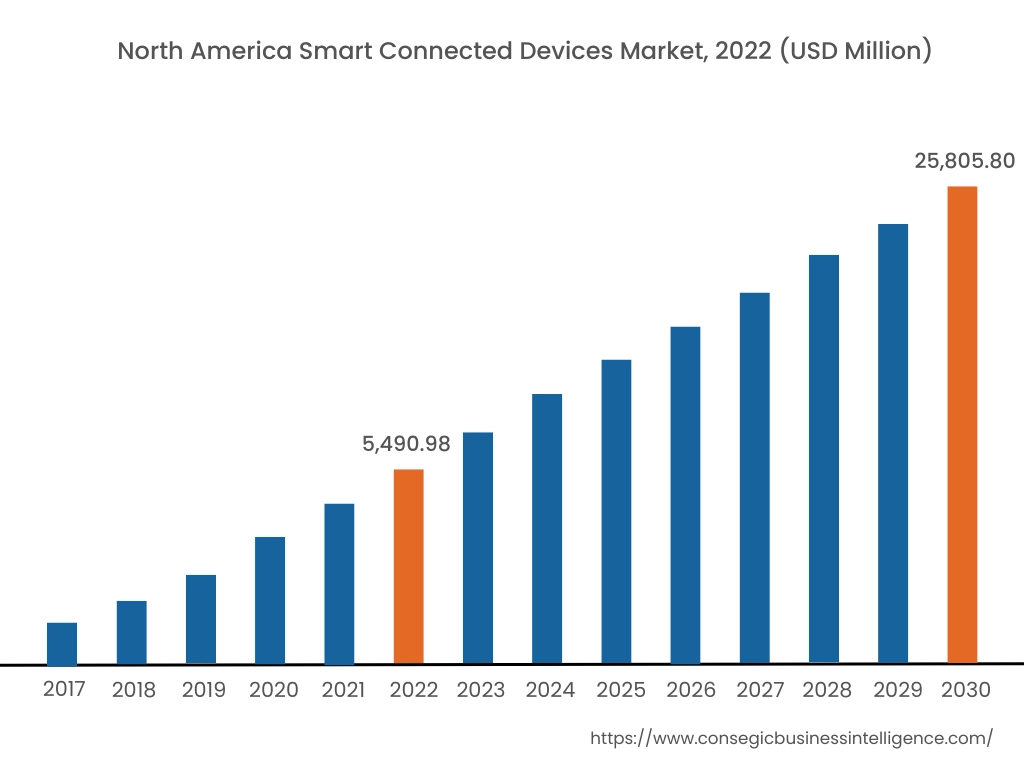
North America accounted for the largest revenue share of USD 5,490.98 Million in 2022 and is expected to reach USD 25,805.80 Million by 2030, registering a CAGR of 21.7% during the forecast period. In addition, in the region, the U.S. accounted for the maximum revenue share of 68.50% in the same year. The adoption of smart connected devices in North America is primarily driven by multiple factors including rising investments in building and construction projects and increasing installation of smart devices in residential and commercial buildings in the region. For instance, according to Statistics Canada, investments in the building & construction sector reached USD 20.4 billion in January 2023, representing an increase of 1.5% in comparison to the previous year. Moreover, investments in the residential sector in Canada increased by 1.9% to USD 14.9 billion, while the non-residential sector increased by 0.5% to USD 5.6 billion in January 2023. The above factors are anticipated to drive the adoption of smart connected devices in residential and commercial buildings to offer enhanced building operations and improved energy efficiency, in turn driving the market growth in North America during the forecast period.
Asia-Pacific is expected to register fastest CAGR growth of 21.9% during the forecast period. The rapid pace of urbanization, industrialization, and development is creating lucrative opportunities for market growth in the region. Moreover, the rising government initiatives for the development of smart cities in the Asia-Pacific region are contributing to the market growth for smart connected device.
For instance, the government of China launched multiple initiatives including China's 14th five-year Development Plan (2021 to 2025), National New-type Urbanization Plan, and smart cities projects with the aim of supporting the development of smart homes in the country. Additionally, several factors including the rise in commercial and industrial construction along with growing need for smart automated solutions are projected to drive the market demand for smart connected devices in the Asia-Pacific region during the forecast period.
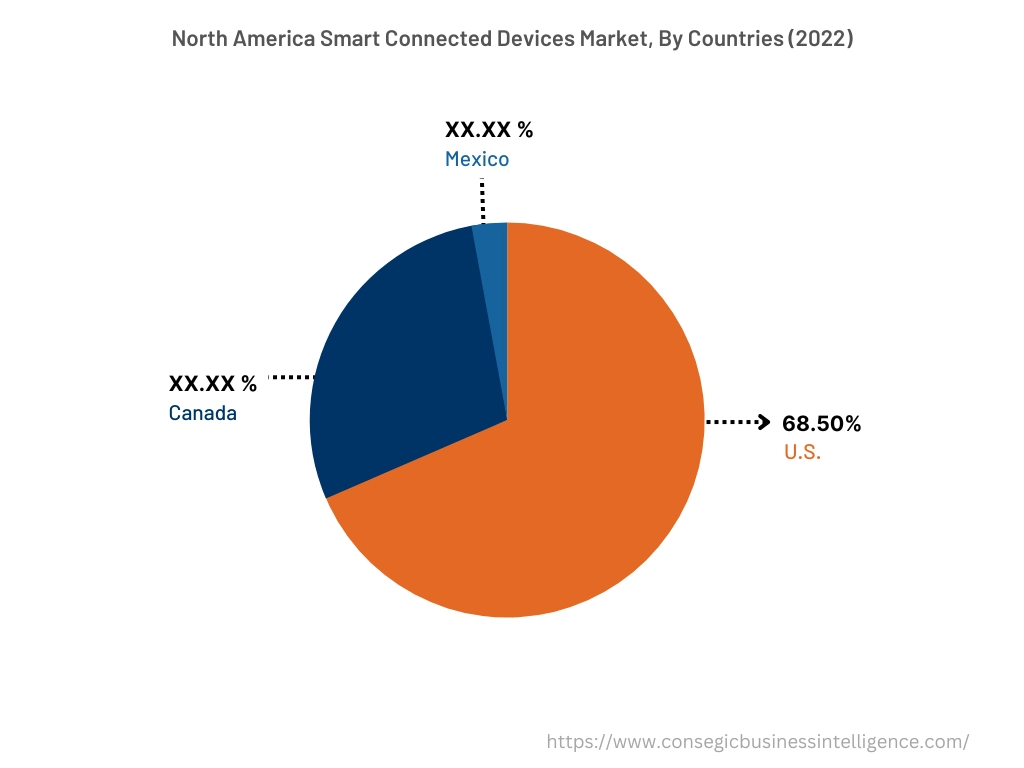
Top Key Players & Market Share Insights:
The smart connected devices market is highly competitive with major players providing smart connected devices to the national and international markets. Key players are adopting several strategies in research and development (R&D), product innovation, and application launches to hold a strong position in smart connected devices market. Key players in the smart connected devices market include-
- Rockwell Automation
- Sony Electronics Inc.
- HTC Corporation
- Apple Inc.
- Lenovo
- LG Electronics
- NXP Semiconductor
- Broadcom
- PTC
- SAMSUNG
Recent Industry Developments :
- In March 2023, Sony Electronics Inc. introduced its new line-up of BRAVIA XR smart TV that is designed to offer enhanced home entertainment experience. The BRAVIA XR smart TV line-up are available in five models that are equipped with features for providing consumers with an immersive experience for watching movies, gaming, and streaming apps.
Key Questions Answered in the Report
What is smart connected devices? +
Smart connected devices refer to electronic devices that are often connected to other devices or networks through various wireless protocols and are capable of operating interactively and autonomously.
What specific segmentation details are covered in the smart connected devices report, and how is the dominating segment impacting the market growth? +
For instance, by type segment has witnessed enterprise IoT devices as the dominating segment in the year 2022, owing to its increasing utilization in commercial buildings such as offices, educational institutions, retail outlets, and others.
What specific segmentation details are covered in the smart connected devices market report, and how is the fastest segment anticipated to impact the market growth? +
For instance, by end-user segment has witnessed residential as the fastest-growing segment during the forecast period due to the rising adoption of smart connected devices such as smart TVs, smart speakers, smart appliances, and others in modern residential buildings.
Which region/country is anticipated to witness the highest CAGR during the forecast period, 2023-2030? +
Asia-Pacific is anticipated to register fastest CAGR growth of 21.9% during the forecast period due to rapid pace of urbanization and rising building & construction projects in the region.
